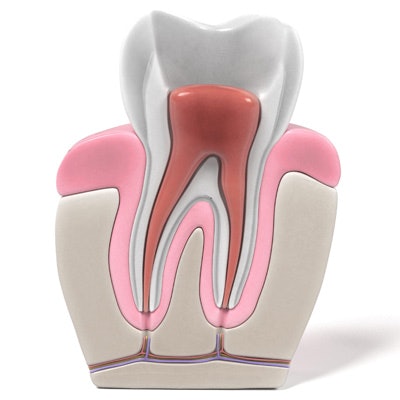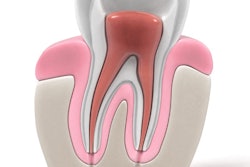
What factors are responsible for the survival of a tooth treated endodontically using a titanium post and a bonded amalgam restoration? While the remaining tooth structure is the key component, what else influences survival of these teeth?
A long-term evaluation of treatment using a titanium post and a bonded amalgam core restoration with a metal-ceramic crown found that the tooth location in the mouth had the most influence on survival rates, according to researchers from Spain in a study published in the Journal of the American Dental Association (February 2017, Vol. 148:2, pp. 75-80).
"It can be concluded that bonding amalgam cores in endodontically treated molars results in greater survival rates than in anterior teeth," wrote study authors Martín Caserío Valea, DDS, and Victor Alonso de la Peña, PhD, MD, DDS.
Dr. Valea is a postgraduate dental student in the faculty of medicine and dentistry at the University of Santiago de Compostela School of Dentistry in Lugo, Spain. Dr. Alonso de la Peña is an associate professor in the same faculty.
Tooth location
Previous research has suggested that a post should be place if an endodontically treated tooth will be expected to have a load placed on it. Using titanium posts and bonded amalgam restorations to restore these teeth has shown good long-term survival results, the study authors noted. But why does this treatment succeed? What factors are key to a restoration's long-term survival?
The researchers conducted a retrospective study over a period of 18 to 22 years to evaluate restorations using a titanium post (Unimetric, Dentsply Sirona) with a bonded amalgam core and metal-ceramic crown. The impression for the crowns were made with addition-cured silicone (3M ESPE).
"The most suitable material for the metal post is titanium, which causes less corrosion and is more biocompatible than magnesium or zinc," the authors wrote.
The researchers placed 88 restorations over a four-year period from 1992 through 1996 in 66 patients (42 women) with a mean age of 44 years at the time of treatment. The types of teeth are listed in the table below.
| Locations of restorations placed (n = 88) | ||
| Tooth type | Maxillary | Mandibular |
| Incisors | 6 | 0 |
| Canines | 12 | 6 |
| Premolars | 24 | 4 |
| Molars | 16 | 20 |
Survival rates decreased over time, from almost 90% at the five-year follow-up to less than 65% at the 18-year follow-up. Overall, the authors reported 42 failures out of the 88 restorations on follow-up, with the causes of failure shown in the table below.
| Causes of failures | |
| Cause | Number (out of 42) |
| Loss of retention | 10 |
| Subgingival caries | 10 |
| Radicular fracture | 9 |
| Endoperiodontal pathology | 7 |
| Marginal filtration | 6 |
Knowing the causes of the failures, the researchers then analyzed the following variables to see which contributed to the success or failure of the restorations:
- Ferrule length (0 mm to less than 2 mm; 2 mm and greater)
- Post length (8.25 mm, 9.5 mm, 11.5 mm, and 13.5 mm)
- Post thickness (0.8 mm, 1.0 mm)
- Tooth location in the mouth
“Bonding amalgam cores in endodontically treated molars results in greater survival rates than in anterior teeth.”
They found statistically significant differences in survival rates depending on tooth location, with higher survival rates for molars and the most failures in maxillary premolars. The cores in the anterior teeth were 3.26 times more likely to fail than those in the molars, the authors reported.
When considering the length of the ferrule (defined as the necessary dentin circumferential area, with a minimum height of 1.5 mm to 2 mm, to obtain an adequate fracture resistance), the authors reported that teeth with a ferrule length of 2 mm or more had a higher survival rate than those with a shorter ferrule length. They noted that these results were not statistically significant.
Restorations with posts with a 0.8-mm diameter had a lower survival rate than posts with a 1.0-mm diameter, although the differences in survival rates also were not statistically significant. Post length did not influence the survival of the restorations as well, the authors concluded.
Study results differ
A 2006 retrospective study in the International Journal of Prosthodontics (March/April 2006, Vol. 19:2, pp. 136-142) found no differences in survival rates according to the tooth location in the mouth at the 18-year follow-up, the current study authors noted. However, they also cited two studies with similar results to their evaluation in terms of molars having greater survival rates: a 2009 study in the Journal of Oral Rehabilitation (April 2009, Vol. 36:4, pp. 299-312) and a 2011 in the Journal of Prosthodontic Research (April 2011, Vol. 55:2, pp. 69-74).
"Neither the length of the metallic post nor its diameter influenced restoration survival," the authors concluded.



















